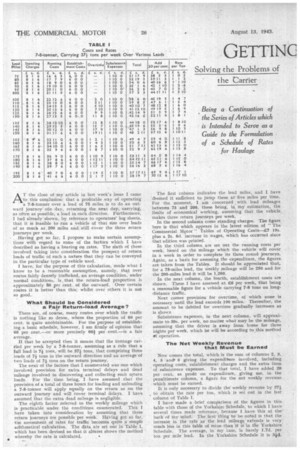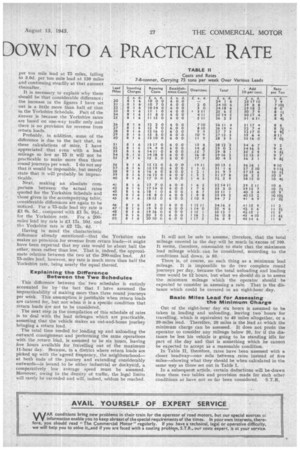GETTINC
Page 22

Page 23

If you've noticed an error in this article please click here to report it so we can fix it.
DOWN TO A PRACTICAL RATE
Being a Continuation of the Series of Articles which is Intended to Serve as a Guide to the Formulation of a Schedule of Rates for Haulage
T the close of my article in last week's issue I came f-kto this conclusion: that a profitable way of operating
a 7-8-tonner over a lead of 75 miles is to do an outward journey ofie day, returning the .next day, carrying, as often as possible, a load in each direction. Furthermore, I had already shown, by reference to operators' log sheets, that it is feasible to run a vehicle of that size over leads of as much as.200 miles and still cover the three return journeys per week.
Having got so far, I propose to make certain assumptions with regard to some of the factors which I have described as having a bearing on rates. The sixth of these involved taking into consideration the prospect of return loads of traffic of such a nature that they can be conveyed in the particular type of vehicle used.
I have, for the purpose of this calculation, made what 1 know to be a reasonable assumption, namely, that over routes fairly densely trafficked, an average condition, under normal conditions, is . that the rettirn-Toad proportion is approximately a0 per cent. of the outward. Over certain routes it is better than this; whilst over' others it is not so good,
What Should be Considered a Fair Return-load Average?
There are, of course, many routes over which the traffic is nothing like so dense, where the proportion of 60 per cent. is quite unobtainable. For the purpose of establishilia,* a basic schedule, however, I am firmly of opinion that 60per cent.---or more precisely 664 per cent.—is a fair average.
If that be accepted then it means that the tonnage carried per week by a 7-8-tonner, assuming as a rule that a full load is 74 tons, will be 374 tons, that comprising three loads of 74 tons in the outward direction and an average of two loads of 74 tons on the return journey.
The next of the factors that I enumerated was one which involved provision for extra terminal delays and dead mileage involved in discovering and collecting such return. loads. For the time being, I have assumed that the , provision of a total of three hours for loading and unloading a 7-8-tonner will apply equally on the return as on the outward journey and will cover terminal delays. I have assumed that the extra dead mileage is negligible.
The eighth factor referred to the weekly mileage which is practicable under the conditions enumerated. ThiS I have taken into consideration by assuming that three return journeys are possible per week. Having got so far, the assessment of rates for .traffic becomes quite a simple arithmetical calculation. The data are 'set out in Table which has been devised so that it almost shows the method • whereby the rate is calculated.
The first column indicates the lead miles,. and I have 'deemed it sufficient to jump these atfive miles per time. For the moment, I am concerned , with lead mileages between 75 and 200, these being, in my estimation, the limits of economical working, assuming that' the vehicle, makes three return journeys per week.
In the second column come standing charges. The figure here is that which appears in the latest edition of " The Commercial Motor Tables of Operating Costs—£7 19s. plus a 2s. 6d. increase in wages, which has occurred since -that edition was printed.
In the third column, are set out the running costs per week, based on the mileage which the vehicle will cover in a week in order to complete its three round, journeys. Again, as a basis for assessing the expenditure,. the figures are taken from the Tables. It should be appreciated that, for a 75"-miles lead, the Weekly mileage will be 250 and for the 200-miles lead it will be 1,200.
In the next column, the fourth, establishment costs are shown. These I have assessed at £6 per week, that being a reasonable figure for a vehicle carrying 7-8. tons on longdistance traffic.
Next comes provision for overtime, of which none is necessary 'until the lead exceeds 100 miles. Thereafter, the amount to be debited for overtime gradually increases as is shown Subsistence expenses, in the next column, will approximate to 30s. per week, no matter what may be the mileage, assuming that the driver is away from home for three nights per week, which he will be according to this method Of operation.
The Net Weekly Revenue that Must be Earned
Now comes the total, which is the sum of columns 2, 3, 4, 5 'and* 6 giving the expenditure involved, including operating costs, establishment charges and the extra item of subsistence expenses. To that total, I have added 20 per cent, as profit on expenditufe, giving me, in the penultimate column, a figure for the net weekly revenue which must be earned.
It is only necessary to divide the weekly revenue by 374 to obtain the rate per ton, which is set out in the last column of Table I.
I have made a brief comparison of the figures in this table with those of the Yorkshire Schedule, to which I have several times made reference, because I have this at the' back of my mind. The first thing to be noted is that the increase in the rate as the lead mileage extends is very much less in this table of mine, than it is in the Yorkshire Schedule. The average, in' my case, is barely 1.7d. per ton per mile lead. In the Yorkshire Schedule it is 34d.
per ton mile lead at 75 miles, falling to 3.0d. per ton mile lead at 130 miles and continuing steadily at that amount thereafter.
It is necessary. to explain why there should be that considerable difference ; the increase in the figures I have set out is a little more than half of that in the Yorkshire Schedule. Part of the answer is because the Yorkshire rates are based on one-way traffic only and there is no provision for revenue from return loads.
Probably, in addition, some of the difference is due to the fact that, in these calculations of • mine, I have appreciated that even with a lead mileage so low as 75 it will not be practicable to make more than three' round journeys per week. I-do not say that it would be impossible, but merely state that it will probably be impracticable.
Next, making an absolute comparison between the actual rates quoted. for the Yorkshire Schedule and those given in the accompanying table', considerable differences are again to be noticed. For a 75-mile lead my rate is El es. 5d., compared with £.1 3s.
for the Yorkshire rate. For a 200miles lead My rate is V 17s. 10d, and Yorkshire rate is £.2 12s. 4d. Having in mind the characteristic difference already mentioned—that the Yorkshire rate makes no prmision for revenue from return loads—it might have been expected that my rate would be about half the other, more rather than less. That is, indeed, the approximate relation between the two at the 200-miles lead. At 75-miles lead, however, my rate is much more than half the Yorkshire rate, being nearly the equal thereof.
49 SO
Explaining the Difference Between the Two Schedules This difference between the two schedules is entirely accounted for by the fact that I have assumed the impracticability of making more than three round journeys per week. This assumption is justifiable when return lciads are catered for, but not when it is a specific condition that return loads a:re not to be considered. .
The next step in the compilation of this schedule of rates. is to deal with the lead mileages which are practicable, assuming that the vehicle makes an out-and-home journey bringing a return load.
The total time needed_ for loading up and unloading the outward consignment-and performing the same operations with. the return Iciad, is assumed to be six hours, leaving five hours available for :travelling out of the maximum 11-hour day. 'Because, in a district where return loads are picked up with the agreed frequency, the neighbourhood— at both ends of the journey and extending considerably outwards—is bound to be either -industrial or dockyard, a comparatively low average Speed must be assumed. Moreover, owing to the density of traffic, the legal limits will rarely be exceeded and will, indeed, seldom be reached. It will not be safe to assume, therefore, that the total mileage covered in the day will be much in excess of' 100. It seems, therefore, reasonable to state that the maximum lead mileage which. can be considered, according to the conditions laid down, is 50.
There is, of course, no such thing as a minimum lead mileage. It is impossible to do two complete round journeys per day, because the total unloading and loading time would be 12 hours, but what we should do is to assess the minimum mileage which the operator should be expected to consider in assessing a rate. That is the distance which could be covered in an eight-hour .day.
Basic Miles Lead for Assessing the Minimum Charge Out of the eight-hour day six hours is assumed to be taken in loading and unloading, leaving two' hours for travelling, which is equivalent to 40 Miles altogether, or a 20-miles lead. Therefore, 20 miles is the lead at which the minimum charge can be assessed. It does not profit the operator to consider any mileage below 20, for if the distancebe less his vehicle is going to be standing idle for part of the day and that is something which he cannot be expected to accept as a reasonable condition.
In Table II, therefore, rates have been assessed with a closer headway—one mile between ,rates instead of five miles—showing what they should be when calculated in the same way as those set out in Table I.
In a subsequent article, certain deductions will be-drawn • from these two tables and provision made for such other conditions as have not so far been considered, S.T.R.




















































